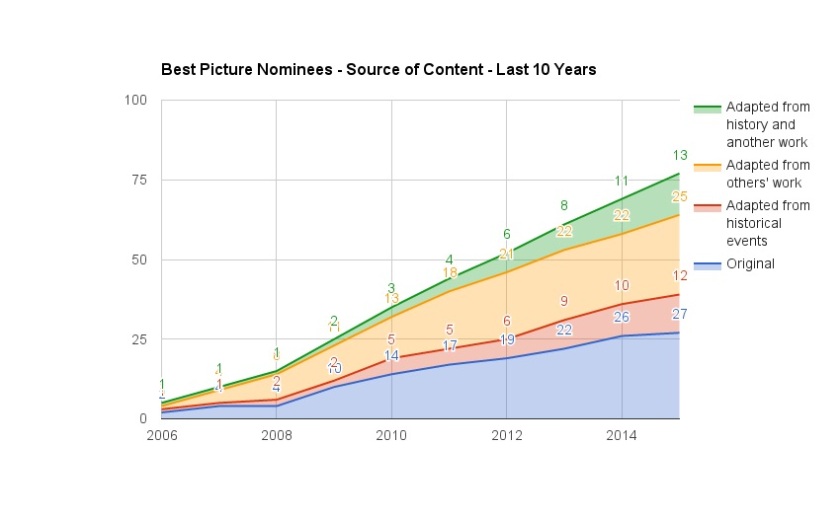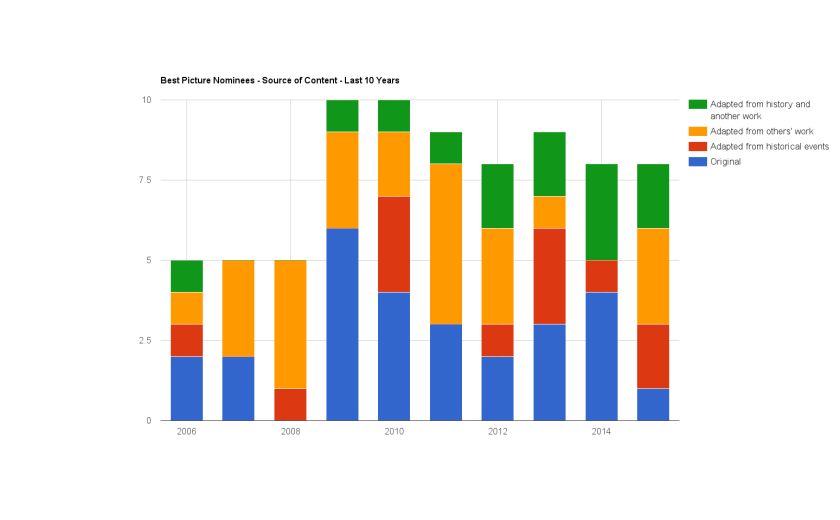
Wait. Are you talking to me?
Yes, Confused Italicized Questioning Alter Ego. I am.
It feels different…
Yeah! Cause I threw some italics on you and removed the “Q&A” bit of it.
But why?
Cause you talk too much to only ask questions. And I felt like italics were less limiting than “Q&A.” Think of it as an upgrade, even though I’m totally stealing this idea from about a million other blogs.
Nice! Okay. What’s “kind of” our concern, dude?
THIS!

That really doesn’t look like much, dude…
Allow me to explain, CIQAE.
As you know, I’ve complained extensively about the lack of quality, original content produced in the filmmaking world, and cited it as one of the main reasons I thought Mad Max: Fury Road should win Best Picture over Spotlight, The Revenant and The Big Short. I decided I’d complained enough. It was time to do some real research and see if the lack of quality original content was as big of a problem as I thought it was.
Can you talk a little bit about that chart you just threw up? I mean, the colors are pretty, but I’m somewhat unsure what I’m looking at.
Hang with me, CIQAE. I’m new to making charts on Google Docs, so they aren’t great. Basically I wanted to show the distribution of films nominated for Best Picture over the past 10 years and where their content spawned. I’ve separated the films into four categories:
- Completely Original (ex. Mad Max: Fury Road) — The idea that started the project was from a story created by a writer. In the case of the example, George Miller created Mad Max. Sure, it can be influenced by the world or history or politics or whatever you want, but the essence is the story itself was thought up by someone, rather than deriving from historical truths–
Wait, wait, wait. Anything that was adapted from a book, wouldn’t that be original? I mean, novels are usually pretty original–
Not now, Cato! I’m getting there. Just shut up and let me talk for a bit.
I mean, I’m just saying–
Okay! I’ll redefine it, damn it.
Thank you.
- Completely Original to Film (ex. Mad Max: Fury Road) — a story that’s first medium was a screenplay that can be influenced by history but is not an adaptation of a preexisting story
- Adapted for Film (ex. Room) — a story that’s first medium was something other than film, such as a novel, short story, play, etc
- Adapted from History (ex. Spotlight) — a story that existed before it was written, but its first medium was a screenplay
- Adapted from Another Work that Adapted History (ex. The Big Short) — a story that existed before it was written, was then written for another medium, such as a book, and then adapted for film
Does your ordering indicate your personal preference?
Eh. Of course I’m partial to work that is completely original to film, but after that anything can pretty quickly merit a frown on my end. If I had to pick a number two it’d be “Adapted from History” when it’s done well, which doesn’t mean it stayed true to history, just that I believe the story to be well told. For the record, the Academy considers scripts that are adapted from true, historical events to be “Original Screenplays.”
But they’re wrong…?
Now you’re getting the hang of it. Here, how about I give you another graph:

I like this graph more.
I think I do, too. It does a good job showing content distribution.
All right. You said we should be concerned. Talk me through that.
So I guess the best place to look if you want to be concerned is 2009. That’s the year the Academy decided it would nominate between six and 10 features for Best Picture, rather than cutting it off at five. Look at that blue, baby! In 2009, six completely original films were nominated for Best Picture.
I bet you think that’s just fan-tootin-tastic.
You know me so well. But didn’t someone in a Batman movie once say, “The day is brightest before the dusk”?
Sounds about right.
Exactly. And look at that downtrend afterwards in completely original nominees. Since the field expanded to a maximum of 10 nominees, we’ve yet to see more than half the nominated films be completely original. Last year was a surprisingly good year, as four of the eight were original for the movies. But the data suggests that’s more of an anomaly than regular occurrence. Since 2009, there have been 62 films nominated for Best Picture; just 23 of them have been completely original, a measly 37%. That number looks even worse if you remove 2009 and 2010, revealing in the last five years there have been 42 nominees, 13 of them original, for a score of 30%.
So what’s pushing out the original content and taking its spots? It kinda looks like–
My blog! I get to say the reveals, CIQAE!
–stories adapted from history into other mediums and then adapted to film.
… congrats. You passed elementary math.

But yes! You’re absolutely right. From 2006 to 2011, just four of the 44 films fit into that category, for a tiny 9%. That’s about as significant as Ben Carson and John Kasich combined.
Nice one!
Flattery will get you nowhere, CIQAE. This is a professional relationship. I can’t handle anything more, right now.
Since 2011, though, of the 33 nominees, nine fall into that category for–
That’s 27%.
Oh. You can multiply by three now? Congrats, again.
There have also been interesting trends in stories based on historical events, such as Spotlight. From 2006 to 2009, there were just two of such films out of the 25 Best Picture nominees. You wanna do that math, bud?
8%.
Nice. But in the past six years, 10 of the 52 nominated films were based on history, which is 19%. While that number climbed, stories adapted from other mediums (often novels, but not always) stayed relatively consistent other than a two year spell from 2013 to 2014 where just one nominee was adapted from another medium and nothing else (it was Philomena [2013] if anyone cares). There were others adapted from books, such as The Wolf of Wall Street (2013), 12 Years A Slave (2013) and The Theory of Everything (2014), but I put those in the “another work based on history that was adapted to the screen” because they were all adapted from autobiographies.
So what about the Best Picture winners, rather than just the nominees? You got a graph for that, too?
Well. No. But–
Make one! Make one!
No! I tried. Google Docs couldn’t handle how boring it was. So here’s the info:
- Completely original – The Hurt Locker (2009), The Artist (2011), Birdman (2014)
- Adapted from another medium – The Departed (2006), No Country for Old Men (2007), Slumdog Millionaire (2008)
- Adapted from history – The King’s Speech (2010), Spotlight (2015)
- Adapted from both – Argo (2012), 12 Years A Slave (2013)
There aren’t any crazy takeaways from this because the distribution is very even. It’s worth noting it’s been seven years since a story adapted from another medium won, and something adapted from another medium and history has won twice, but both in the past four years. Also, the only completely original winner I didn’t have real issues with was The Hurt Locker. So who really knows.
Kinda feels like you did a lot of work for nothing. Maybe it’s time to wrap this article up. Want to share some closing thoughts?
Sure. It’s obviously challenging to draw any definitive conclusions when the data is limited. It’s also possible that 20 years from now I could look back and think of the past five years as a bump in the otherwise smooth road. I can’t imagine that will be the case, though, so I’m just glad I don’t care that much who wins the Oscars.

I protest! You DO care, perhaps not in the fanboy sense, but because it influences what gets made…and which aspiring screenwriter’s scripts are purchased.
LikeLike